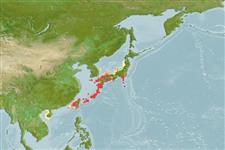Klassifizierung / Names
Namen | Synonyme | Catalog of Fishes(Gattung, Arten) | ITIS | CoL | WoRMS | Cloffa
>
Gobiiformes (Gobies) >
Gobiidae (Gobies) > Gobiinae
Etymology: Eviota: No etymology given, suggested by Christopher Scharpt: from Latin 'eu' for 'true' and 'iota' for anything very small, in combination 'truly very small' referring to it as being the smallest vertebrate at the time it has benn described by Jenkins (thus, making the suggestion by Scharpt plausible; specca: Name based on the Anglo/Saxon 'specca' for speckled, referring to the heavy speckling of chromatophores over the body; noun in apposition.
Environment: milieu / climate zone / Tiefenbereich / distribution range
Ökologie
seewasser riff-verbunden; tiefenbereich 5 - 14 m (Ref. 95167). Subtropical
Northwest Pacific: Japan, Ryukyu Is..
Size / Gewicht / Alter
Geschlechtsreife: Lm ? range ? - ? cm
Max length : 1.2 cm SL Männchen/unbestimmt; (Ref. 95167)
Kurzbeschreibung
Bestimmungsschlüssel | Morphologie | Morphometrie
Rückenflossenstacheln (insgesamt) : 7; Rückenflossenweichstrahlen (insgesamt) : 8; Afterflossenstacheln: 1; Afterflossenweichstrahlen: 8; Wirbelzahl: 26. This species is distinguished from its congeners by the following set of characters: cephalic sensory pore system pattern 1 (complete); 8/8 dorsal/anal-fin formula; body heavily sprinkled with chromatophores; upper pectoral-fin base pigmented; 4 subcutaneous body bars between anal-fin origin and caudal-fin base; occipital spot absent; pale opercular membrane; first dorsal fin sprinkled with small melanophores and chromatophores; caudal peduncle with no distinct dark spot or bar; cheek crossed by dark lines, red spots absent (Ref. 95167).
Cross section: oval.
Life cycle and mating behavior
Geschlechtsreife | Fortpflanzung | Ablaichen | Eier | Fecundity | Larven
Greenfield, D.W., T. Suzuki and K. Shibukawa, 2014. Two new dwarfgobies of the genus Eviota from the Ryukyu Islands, Japan (Teleostei: Gobiidae). Zootaxa 3774(5):481-488. (Ref. 95167)
IUCN Rote Liste Status (Ref. 130435: Version 2025-1)
Bedrohung für Menschen
Harmless
Nutzung durch Menschen
Tools
Zusatzinformationen
Download XML
Internet Quellen
Estimates based on models
Preferred temperature (Ref.
123201): 20.5 - 26.3, mean 23.3 °C (based on 102 cells).
Phylogenetic diversity index (Ref.
82804): PD
50 = 0.5000 [Uniqueness, from 0.5 = low to 2.0 = high].
Bayesian length-weight: a=0.00692 (0.00284 - 0.01683), b=3.10 (2.92 - 3.28), in cm total length, based on LWR estimates for this Genus-body shape (Ref.
93245).
Trophic level (Ref.
69278): 2.9 ±0.3 se; based on size and trophs of closest relatives
Widerstandsfähigkeit (Ref.
120179): hoch, Verdopplung der Population dauert weniger als 15 Monate. (Preliminary K or Fecundity.).
Fishing Vulnerability (Ref.
59153): Low vulnerability (10 of 100).
🛈
